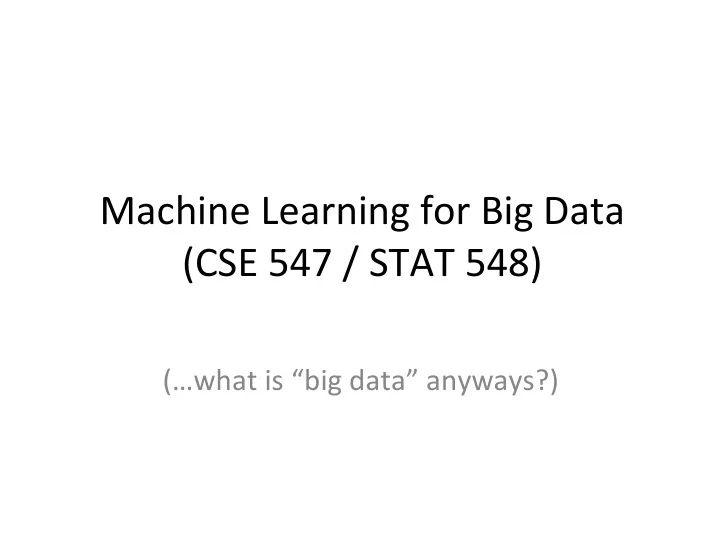

Machine ¡Learning ¡for ¡Big ¡Data ¡ (CSE ¡547 ¡/ ¡STAT ¡548) (…what ¡is ¡“big ¡data” ¡anyways?)
Course ¡Staff Instructor: • Sham ¡Kakade Two ¡Great ¡TAs: (interact ¡with ¡them. ¡learn.) • Aravind Rajeswaran • Yali Wan
CONTENT What ¡is ¡the ¡course ¡about?
Course ¡Structure • Some “case ¡studies” – Estimating ¡Click ¡Probabilities – Document ¡Retrieval – fMRI ¡Prediction – Collaborative ¡Filtering – ?? • Not ¡comprehensive, ¡but ¡a ¡sample ¡of ¡tasks ¡and ¡ associated ¡solution ¡methods • Methods ¡broadly ¡applicable ¡beyond ¡these ¡case ¡ studies
1. ¡Estimating ¡Click ¡Probabilities • Goal: ¡ Predict ¡whether ¡a ¡person ¡clicks ¡on ¡an ¡ad • Basic ¡method: ¡ logistic ¡regression, ¡online ¡learning Query Yes! Ad ¡Info MODEL No Features ¡ of ¡user
1. ¡Estimating ¡Click ¡Probabilities • Challenge ¡I: ¡ Overfitting, ¡high-‑dimensional ¡feature ¡space • Advanced ¡method: L2 ¡regularization, ¡hashing Query Ad ¡Info MODEL Features ¡ of ¡user
1. ¡Estimating ¡Click ¡Probabilities • Challenge ¡II: ¡ Dimension ¡of ¡feature ¡space ¡changes – New ¡word, ¡new ¡user ¡attribute, ¡etc. • Advanced ¡method: sketching, ¡hashing
2. ¡Document ¡Retrieval • Goal: ¡ Retrieve ¡documents ¡of ¡interest ¡ • Methods: ¡ fast ¡K-‑NN, ¡k-‑means, ¡mixture ¡models, ¡Hadoop
3. ¡fMRI ¡Prediction • Goal: ¡ Predict ¡word ¡probability ¡from ¡fMRI ¡image • Challenge: ¡ p ¡>> ¡n ¡(feature ¡dimension ¡>> ¡sample ¡size) • Methods: ¡ L1 ¡regularization ¡(LASSO), ¡parallel ¡learning HAMMER MODEL or HOUSE
3. ¡fMRI ¡Prediction • Goal: ¡ Predict ¡fMRI ¡image ¡for ¡given ¡stimulus • Challenge: ¡ zero ¡shot ¡learning ¡(generalization) • Methods: ¡ features ¡of ¡words, ¡Mechanical ¡Turk, ¡ graphical ¡LASSO Features ¡ MODEL of ¡word GIRAFFE HORSE
4. ¡Collaborative ¡Filtering • Goal: ¡ Find ¡movies ¡of ¡interest ¡to ¡a ¡user ¡based ¡on ¡ movies ¡watched ¡by ¡the ¡user ¡and ¡others • Methods: ¡ matrix ¡factorization, ¡latent ¡factor ¡models, ¡ GraphLab
Women ¡on ¡the ¡Verge ¡of ¡a Nervous ¡Breakdown The ¡Celebration City ¡of ¡God What ¡do ¡I ¡ recommend??? Wild ¡Strawberries La ¡Dolce ¡Vita
4. ¡Collaborative ¡Filtering • Challenge: ¡ Cold-‑start ¡problem ¡(new ¡movie ¡or ¡user) • Methods: ¡ use ¡features ¡of ¡movie/user IN ¡THEATERS
Scalability • Throughout ¡case ¡studies, ¡introduce ¡notions ¡of ¡ parallel ¡learning ¡and ¡distributed ¡computations
Assumed ¡Background Official ¡Prereq ¡(strict): ¡ CSE ¡546 ¡or ¡STAT ¡535 Know ¡specific ¡topics: • Linear ¡and ¡logistic ¡regression, ¡ridge ¡regression, ¡LASSO • Basic ¡optimization ¡(e.g., ¡gradient ¡descent, ¡SGD) • Perceptron ¡algorithm • K-‑NN, ¡k-‑means, ¡EM ¡algorithm Comfortable ¡with: • Java ¡or ¡Python • Ability ¡to ¡learn ¡programming ¡languages ¡(TensorFlow?) • Probabilistic ¡and ¡statistical ¡reasoning • Linear ¡Algebra Computational ¡and ¡mathematical ¡maturity
LOGISTICS How ¡is ¡the ¡course ¡going ¡to ¡operate?
Diversity/Gender ¡Issues • An ¡acknowledgement: ¡there ¡are ¡ diversity/gender ¡issues ¡to ¡overcome. – Please ¡be ¡mindful ¡of ¡this.
Website ¡and ¡Catalyst • Course ¡website: courses.cs.washington.edu/courses/cse547/17s p/index.html • Canvas: – Used ¡for ¡all ¡discussions!! – Post ¡all ¡questions ¡there ¡(unless ¡personal) – Homework ¡collection – Personal: ¡cse547-‑instructors@cs.washington.edu
Reading • Required textbook: • “Machine ¡Learning: ¡A ¡Probabilistic ¡Perspective” Kevin ¡P. ¡Murphy • Also, ¡readings ¡will ¡be ¡from ¡papers ¡linked ¡to ¡on ¡ course ¡website • Please ¡do ¡reading ¡before ¡lecture ¡on ¡topic
Homework • 4 ¡HWs, ¡approx one ¡for ¡each ¡case ¡study • Collaboration ¡allowed, ¡but ¡write-‑ups ¡and ¡coding ¡must ¡ be ¡done ¡individually • You ¡must ¡submit ¡your ¡code. • Due ¡on ¡posted ¡date/time. • Late: ¡(up ¡to) ¡1 ¡day ¡late ¡33%, ¡(up ¡to) ¡2 ¡day ¡late ¡66%, ¡etc • If ¡you ¡plan ¡to ¡be ¡late, ¡DO ¡NOT ¡TAKE ¡THE ¡COURSE. • YOU ¡MUST ¡SUBMIT ¡ALL ¡HW ¡TO ¡PASS ¡THE ¡COURSE ¡ (EVEN ¡IT ¡IS ¡FOR ¡0 ¡CREDIT)
Project • Individual, ¡or ¡teams ¡of ¡two • New ¡work, ¡but ¡can ¡be ¡connected ¡to ¡research • Schedule: SEE ¡WEBSITE ¡FOR ¡ ¡CHANGES ¡TO ¡DATES – Proposal ¡(1 ¡page) ¡– April ¡7 – Progress ¡report ¡/Milestone ¡(3 ¡pages) ¡– May ¡5 – Poster ¡presentation ¡– Thursday, ¡June ¡1, ¡9:00-‑11:30am ¡(YOU ¡MUST ¡MAKE ¡THIS) – Final ¡report ¡(8 ¡pages, ¡NIPS ¡format) ¡– June ¡6
Grading • HWs ¡1, ¡2, 3, 4 ¡(15% ¡each) • Final ¡project ¡(40%) • GRADING ¡QUESTIONS: ¡All ¡regrading/policy ¡change ¡questions ¡ must ¡be ¡requested ¡by ¡email ¡at ¡cse547-‑ instructors@cs.washington.edu. ¡All ¡in ¡personal ¡discussions ¡ (for ¡TAs/instructors) ¡are ¡limited ¡to ¡knowledge ¡based ¡ questions. ¡Regrading ¡may ¡result ¡in ¡any ¡part ¡of ¡the ¡HW ¡set ¡ going ¡up ¡or ¡down.
Support/Resources • Office ¡Hours – TBD • Discussion ¡Board
Conclusion • It ¡will ¡be ¡hard ¡work ¡and ¡fun… • ML ¡is ¡having ¡tremendous ¡impact ¡in ¡ technology/society. What ¡about ¡social ¡impact? – And ¡social ¡good? –
Recommend
More recommend